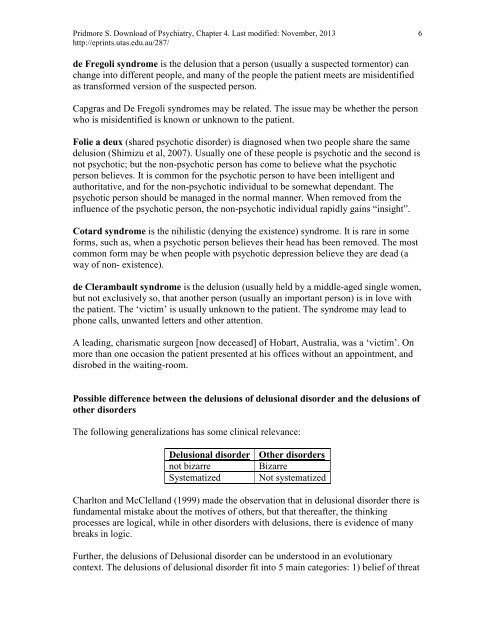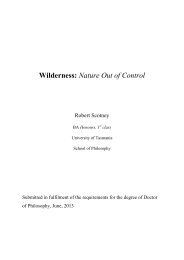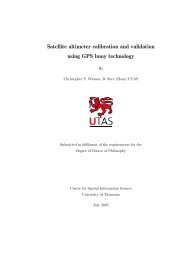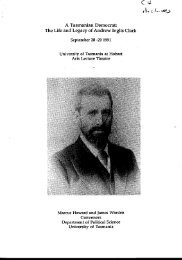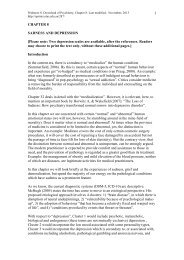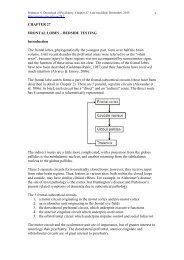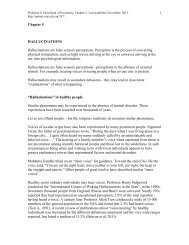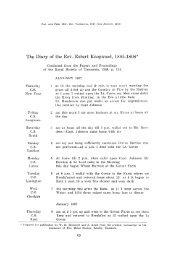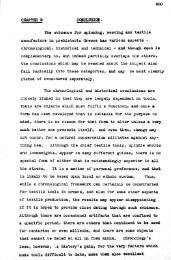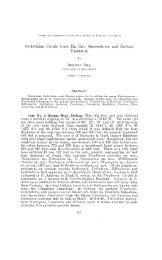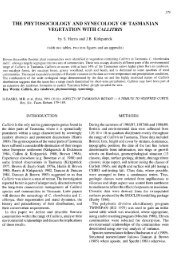PDF (Chapter 4: Delusions and Delusional Disorder) - UTas ePrints
PDF (Chapter 4: Delusions and Delusional Disorder) - UTas ePrints
PDF (Chapter 4: Delusions and Delusional Disorder) - UTas ePrints
Create successful ePaper yourself
Turn your PDF publications into a flip-book with our unique Google optimized e-Paper software.
Pridmore S. Download of Psychiatry, <strong>Chapter</strong> 4. Last modified: November, 2013<br />
http://eprints.utas.edu.au/287/<br />
6<br />
de Fregoli syndrome is the delusion that a person (usually a suspected tormentor) can<br />
change into different people, <strong>and</strong> many of the people the patient meets are misidentified<br />
as transformed version of the suspected person.<br />
Capgras <strong>and</strong> De Fregoli syndromes may be related. The issue may be whether the person<br />
who is misidentified is known or unknown to the patient.<br />
Folie a deux (shared psychotic disorder) is diagnosed when two people share the same<br />
delusion (Shimizu et al, 2007). Usually one of these people is psychotic <strong>and</strong> the second is<br />
not psychotic; but the non-psychotic person has come to believe what the psychotic<br />
person believes. It is common for the psychotic person to have been intelligent <strong>and</strong><br />
authoritative, <strong>and</strong> for the non-psychotic individual to be somewhat dependant. The<br />
psychotic person should be managed in the normal manner. When removed from the<br />
influence of the psychotic person, the non-psychotic individual rapidly gains “insight”.<br />
Cotard syndrome is the nihilistic (denying the existence) syndrome. It is rare in some<br />
forms, such as, when a psychotic person believes their head has been removed. The most<br />
common form may be when people with psychotic depression believe they are dead (a<br />
way of non- existence).<br />
de Clerambault syndrome is the delusion (usually held by a middle-aged single women,<br />
but not exclusively so, that another person (usually an important person) is in love with<br />
the patient. The ‘victim’ is usually unknown to the patient. The syndrome may lead to<br />
phone calls, unwanted letters <strong>and</strong> other attention.<br />
A leading, charismatic surgeon [now deceased] of Hobart, Australia, was a ‘victim’. On<br />
more than one occasion the patient presented at his offices without an appointment, <strong>and</strong><br />
disrobed in the waiting-room.<br />
Possible difference between the delusions of delusional disorder <strong>and</strong> the delusions of<br />
other disorders<br />
The following generalizations has some clinical relevance:<br />
<strong>Delusional</strong> disorder Other disorders<br />
not bizarre Bizarre<br />
Systematized Not systematized<br />
Charlton <strong>and</strong> McClell<strong>and</strong> (1999) made the observation that in delusional disorder there is<br />
fundamental mistake about the motives of others, but that thereafter, the thinking<br />
processes are logical, while in other disorders with delusions, there is evidence of many<br />
breaks in logic.<br />
Further, the delusions of <strong>Delusional</strong> disorder can be understood in an evolutionary<br />
context. The delusions of delusional disorder fit into 5 main categories: 1) belief of threat


